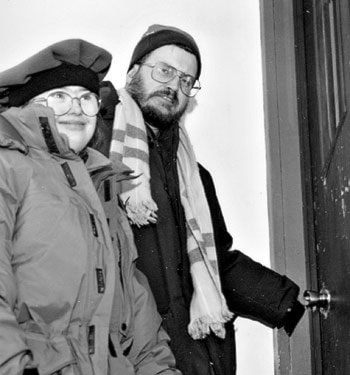No one wants to grow up in an institution; no one should ever have to.
Yet many decades ago, that was the fate of many Yukoners.
Yukon children with pronounced disabilities often became wards of the government and then were sent to an institution in B.C. called Woodlands.
In the 1950s, records show that about 1,400 people lived at Woodlands, the equivalent of a small town.
Barbe Goode, a Vancouverite with an intellectual disability, and an advocate for herself and others, spoke publicly in Whitehorse in 1989 about her years in an institution. “Basically, institutions are terrible. They lock the door behind people… They have up to 10 people in a room. There’s no privacy. I don’t wish anyone to live in one.”
The Yukon eventually stopped sending people with intellectual disabilities to Woodlands in 1976.
Around the same time, Ernie St. Pierre, a staff member at the newly formed Vocational Rehabilitation Centre (now known as Challenge) had realized that the people they were providing training to desperately needed appropriate living situations.
He and his wife, Marilyn, started a for-profit group home for six male adults in the basement of their home in Riverdale. They later opened Headway House, which had nine or 10 beds, in downtown Whitehorse.
In the late 1980s – as part of the larger cross-Canada movement to close many large institutions – the Yukon government initiated plans to bring home the Yukoners still living in Woodlands.
The first person returned in 1989. He was 33 years old and had spent about 20 years in the institution.
Initially he found housing at Headway House, got work at Challenge, and learned to do his own laundry and help with the cooking and shopping.
“I think it was quite exciting and quite strange for him. He would see people on the street and say, ‘I remember that guy,’” said Vicki Wilson, who worked as a support person for this first person to return. “This person had speech, and no issues with hearing or vision. He was mobile. Others faced more challenges.”
Shortly afterwards, a new organization known as Teegatha’Oh Zheh, a Han Gwitch’in name meaning “coming home over the same trail on which you left,” was formed to help ensure the remaining people returning from Woodlands had appropriate housing and supports.
Eventually all five were placed in homes or apartments, although it was a struggle to find appropriate and affordable places as some required 24-hour care.
And, decades later, housing for Yukoners with intellectual disabilities can still be a struggle.
People often need guidance and support to help them learn life and decision-making skills. Some need varying levels of physical and medical care. A few have medical needs that require constant monitoring.
Some children with intellectual disabilities continue to live with their families long after they become adults, for as long as the families are able.
A small number have managed to move into apartments or approved homes that provide supports and the individual attention they need to foster their independence.
Many are placed in group homes or facilities with 24-hour staff supervision.
However, the need is greater than the available options, in both quantity and quality.
“Government is concerned with making sure that people are warm, safe and dry,” notes Colette Acheson, executive director for the Yukon Association for Community Living. “But community living is about being part of the community, knowing your neighbours and having friendships outside your house. It’s about being visible in your home town and participating in things that interest you. Staffed group homes or facilities have a hard time providing any of this.”
For those that need extensive physical care, the options are particularly limited.
Some children and adults with intellectual disabilities end up being permanently housed in Copper Ridge Place, Yukon’s extended care facility.
Julie Robinson, who was YACL’s inclusion co-ordinator for many years, notes the whole experience of placing children and adults with intellectual disabilities in a large care facility highlights that there is still a profound lack of knowledge about what community supports are and can be.
“There are still well-intentioned people who say this is a ‘community-based’ option because you don’t have to send people outside,” said Robinson after Copper Ridge opened its doors in 2002. “They’re defining a community-based option as simple geography and ignoring the quality of what a community life really means. This is re-institutionalizing people.”
The new care facility for proposed for Whistle Bend – expected to be three times the size of Copper Ridge – may again become the only option for people of any age who are seen to have complex needs.
“When government has a vacant bed in a large facility, it might make financial sense to plant a person with an intellectual disability there instead of creating a variety of options,” says Colette Acheson, YACL’s executive director. “We see that as an in-between step; it’s not Woodlands, but it’s also not community living. Ideally we believe a range of housing options should be available – like roommate companion programs or supportive in-home care – that allow for a person’s dignity and autonomy. We need to work together to create more options that will help all of our community members live as independently and with as much quality of life as possible.”
This is the one of a series of articles written by the Yukon Association for Community Living about the changes in the disability community in the Yukon in the last 50+ years.
